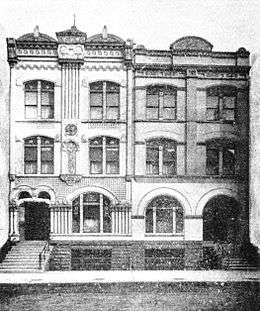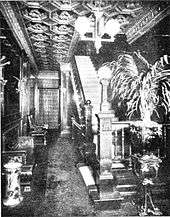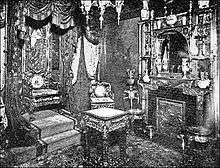Everleigh Club


The Everleigh Club was a high-class brothel which operated in Chicago, Illinois from February 1900 until October 1911.[1] It was owned and operated by Ada and Minna Everleigh.[1]
Opening
The Everleigh Sisters, Minna and Ada, were born near Charlottesville, Kentucky. Minna was born on February 15, 1864. Ada was born July 13, 1866. Initially born with the surname Simms, the sisters took the name Everleigh which was inspired by their grandmother's tradition to sign her letters "Everly Yours." According to the sisters, after two unsuccessful marriages (of which there is no record), the Everleigh sisters left the small town they were raised on in Kentucky (another story concocted by the sisters) for Omaha, Nebraska.[2] It was there where Minna and Ada established their first brothel using money they invested from their $35,000 estate inheritance. In only two years, the women doubled their investment in addition to earning a considerable profit. Minna and Ada closed the brothel and with their recent earnings sought out more lucrative investment opportunities.
Prior to relocating to Chicago, the Everleigh sisters toured brothels in many cities, trying to find a location which had "plenty of wealthy men but no superior houses." They were directed to Chicago by Cleo Maitland, a madam in Washington, D.C., who suggested they contact Effie Hankins in Chicago.[3] After buying Hankins's brothel at 2131–2133 South Dearborn Street, they
fired all the women and completely redecorated the entire building with the most luxurious appointments available. Silk curtains, damask easy chairs, oriental rugs, mahogany tables, gold rimmed china and silver dinner ware, perfumed fountains in every room, a $15,000 gold-leafed piano for the Music Room, mirrored ceilings, a library filled with finely bound volumes, an art gallery featuring nudes in gold frames—no expense was spared. While the heavyweight boxer Jack Johnson thought the $57 gold spittoons in his café were worth boasting about, the patrons of the Everleigh Club were obliged to expectorate in $650 gold cuspidors.[4]
The Everleigh Club was described by Chicago's Vice Commission as "probably the most famous and luxurious house of prostitution in the country".[5]
Prior to the opening of the Everleigh Club, Ada was responsible for recruiting staff for the club. She started by contacting her former employees in Omaha and spreading the word through brothels across the country. She conducted face-to-face interviews with all the applicants.[6] The brothel opened on February 1, 1900 with little fanfare, and turned away many of the clients who initially appeared because the Everleigh Sisters did not deem them suitable for the clientele they were seeking. Once the club was open, Ada, who was quieter and more reserved than her sister, took on the responsibility of making sure the club was kept up to standard. She oversaw cleaning and renovations.[7] Ada was also very much taken with the gold leaf piano in the Club and once claimed she rejected a suitor because he disapproved of the piano.
Expenses
The prices of services provided by the Everleigh Club were extremely inflated by the standards of the day, though these high prices were easily paid by wealthy patrons with an excess of funds. Typically, a patron would initially pay a $10 entrance fee. Patrons could also treat themselves to a variety of amenities that the club offers some of which include: a $12 bottle of wine, a $50 dinner, $25 for supper, or $50 to spend an evening with one of the "Everleigh butterflies." Regardless of what the patron chose to purchase, a minimum of $50 had to be spent by each patron in each visit or they risked having their admission permanently revoked. But patrons had no difficulty reaching the minimum spending. In fact, often clients would spend on an average of $200 to $1,000 a visit.
High costs resulted in high returns for the employees and owners of the Everleigh Club. The Everleigh Sisters netted an average income of an astonishing $15,000 a week compared to the average working wage of only $6 a week. Once the Everleigh sisters retired they had amassed a net profit of $1 million which was equivalent to $20.5 million today.
In addition to rent, salaries, and upkeep, the Everleigh Club expenses also consisted of thousands of dollars in bribes. This expense, even though great, was entirely necessary in order to ensure the business's survival. The Everleigh Club was afforded protection from two corrupt alderman named "Bathhouse" John Coughlin and Michael "Hinky-Dink" Kenna in the Levee District in return for yearly donations of $20,000 to the First Ward Aldermen. The Everleigh Club also donated a check for $3,000 to a roster of corrupt politicians to prevent the passage of anti-vice state legislation. After the club was closed, Minna Everleigh claimed in testimony that she "always entertained state legislators free in the club."[8]
The sisters' separate responsibilities
The Everleigh sisters Minna and Ada—the madams of the Everleigh Club—[1] carried out very different duties in the operation of the club. Ada, the soft-spoken sister, mainly focused on handling all the business transactions, which included handling the books and allocating finances. She did not only take care of the logistics the club required but she also was responsible for hiring new girls. On the other hand, Minna, the outgoing sister, was responsible for carrying out lessons to teach the new girls charm and culture. Her sass lent her the ability to effortlessly interact with guests. Often Minna was seen socializing with guests near the parlors or welcoming them with a friendly greeting into the club. Any duty that required personal interactions was handled by Minna.
Interior layout

The Everleigh sisters spared no expense in their redecoration of their brothel which they named the Everleigh Club. A dozen parlors were located on the first floor. Each parlor consisted of a certain theme such as : the Silver Parlor, the Gold Parlor, the Rose Parlor, or the Japanese Throne Room—all of which appealed to the varying groups of clientele the club received. The upstairs of the Everleigh Club held the private bedrooms where clientele could enjoy a more personal encounter with the women of his choosing alongside luxurious divans, damask chairs, gilt bathtubs and warbling canaries. As luxurious, the dining room's design emulated a private Pullman railroad passenger car with the corresponding ornate gold and mahogany trimmings. The menu featured only the finest entrees such as: duck, caviar, lobster, deviled crab, fried oysters, goose capton, and an excellent selection of wine. It is due to all these extravagant amenities the Everleigh Club was dubbed "probably the most famous and luxurious house of prostitution in the country" by the Chicago Vice Commission.
The Everleigh quickly gained a reputation as an upscale gentlemen's club, so much so that the Everleigh sisters were forced to turn away prospective clients even on opening day on February 1, 1900. The club's extensive popularity afforded Minna and Ada the opportunity to select their clientele. Only those men deemed suitable by Minna and Ada gained admittance into the Everleigh Club. The Everleigh sisters deemed a prospective client "worthy" to be admitted into the club if: the prospective client provided a letter of recommendation from an existing member, an engraved card, or through a formal introduction by Minna or Ada. These standards made the club extremely exclusive, indulging the desires of only the wealthy and influential men. Author Karen Abbott wrote, "The cachet of being able to go there, just because they turned down so many people. It became an exclusive badge of honor just to be admitted."[9]
On March 3, 1902, Prince Henry of Prussia visited the Club while in the United States to collect a ship built for his brother, German Kaiser Wilhelm II. Although the city had sponsored numerous events for Henry, his main interest was a visit to the club. The sisters planned a bacchanalia for the visiting prince, including dancing, dining and a recreation of the dismemberment of Zeus's son. During one of the dances, a prostitute's slipper came off and spilled champagne. When one of the prince's entourage drank the champagne, he started the trend of drinking champagne from a woman's shoe.[10]
The club employed 15 to 25 cooks and maids.[11]
Scandals
On November 22, 1905, Marshall Field, Jr., son of department store founder Marshall Field, suffered a gunshot that would prove to be fatal. Although newspapers reported it was an accident and occurred at his home, there is some evidence that he was shot by a prostitute at the Everleigh Club.[12]
On January 9, 1910, Nathaniel Moore died of natural causes in the Chez Shaw brothel in Chicago's Levee district after spending much of the previous night at the Everleigh Club.[13]
Closing
The Everleigh sisters operated their brothel as a place of luxury and royalty, made available only to the wealthiest and most prominent of clients. This made it more difficult when it came time for reform. Other brothels during this time period would simply be raided by the police and shut down, but because the Everleigh Club in particular had such a reputation for its high standards and exclusivity, officials were not able to dismantle the club so easily.
The Chicago Vice Commission sought to close the Everleigh Club and the entire red-light district of Chicago in an attempt to rehabilitate prostitutes, curb the spread of venereal disease, and cease the crime and violence that was often associated with prostitution (not necessarily within the Everleigh Club). Because of the Everleigh sisters and their lavish club, prostitution during this time period became a glamorized activity, which made it harder to eradicate. Local politics played a large role in deciding how and when the club would be shut down. The Everleigh sisters were known for their tendency to bribe local aldermen to look the other way when it came to legal manners. Following a 1910 Vice Commission report that noted there were nearly 600 brothels in Chicago, Mayor Carter Harrison, Jr. ordered the Everleigh Club to be closed on October 24, 1911.[1][14] The sisters retired with an estimated million dollars in cash and traveled in Europe before eventually changing their name back to Lester and settling in New York City. When their brothel business closed, Ada was 45 years old and Minna was 47 years old.
Minna, always the more outspoken of the two, responded philosophically, stating "If the Mayor says we must close, that settles it.... I'll close up shop and walk out with a smile on my face."[14] And so they did. She later stated "If it weren't for married men, we couldn't have carried on at all, and if it weren't for cheating married women we could have made another million."
Shortly after the brothel was closed, Minna Everleigh testified against Chicago aldermen "Bathhouse" John Coughlin and "Hinky Dink" Kenna. Although Everleigh announced she would make her testimony public, threats by "Big Jim" Colosimo to kill Minna and her sister if the testimony were made public kept her silent. Nevertheless, Chief Justice Harry Olson of Chicago's Municipal Court released her testimony which outlined the schedule of graft due to the aldermen in return for allowing operations to continue in the Levee District.
The building which housed the Everleigh Club was eventually razed in July 1933. Today, the Chicago Housing Authority's Hilliard Homes, designed by Bertrand Goldberg, stand on the site.
In popular fiction
- The novel The Golden Room by Irving Wallace (1989) gives a fictionalized account of the events surrounding the visit of Prince Henry of Prussia to the Everleigh Club, taking great liberties with dates and historical characters.
Notes
- 1 2 3 4 "The Everleigh Club". Chicago Tribune. Retrieved January 26, 2016.
- ↑ Abbott (2007), p.32-46
- ↑ Abbott (2007), p. 7
- ↑ City of the Century, PBS
- ↑ Asbury (1940), p. 250
- ↑ Abbott (2007), p. 18
- ↑ Abbott (2007), pp. 70–71
- ↑ Lloyd Wendt (1974), p. 321
- ↑ Kelly (2007)
- ↑ Abbott (2007), pp. 75–77
- ↑ Asbury (1940), p. 253
- ↑ Abbott (2007), pp. 90–91
- ↑ Abbott (2007) pp. 211-16
- 1 2 "Starts Vice War; Mayor in Fight to Clean Up City". Chicago Daily Tribune. 1911-10-25. p. 1.
References
- Abbott, Karen (2007) Sin in the Second City: Madams, Ministers, Playboys, and the Battle for America's Soul. New York: Random House ISBN 978-1-4000-6530-1
- Asbury, Herbert (1940). Gem of the Prairie. New York: Knopf.
- DuBois, Ellen Carol, and Lynn Dumenil. Through Women's Eyes: An American History with Documents. Boston: Bedford/St. Martin's, 2005. Print.
- Hermann, Charles H. (1945) Recollections of Life & Doings in Old Chicago: from the Haymarket Riot to World War I; by An Old Timer (Charles H. Hermann). Chicago: Normandie House; pp. 240 ff.
- Hibbeler, Ray (1960) Upstairs at the Everleigh Club. Volitant Books
- Kanin, Garson (1980) Smash. New York: Viking
- Kelly, Dan (12 July 2007). "Local History: The Best Little Whorehouse in Chicago". Reader.
- Masters, Edgar Lee (1944) "The Everleigh Club" in: Town & Country, April 1944
- Wallace, Irving (1965) The Sunday Gentleman. New York: Simon & Schuster
- Washburn, Charles (1936) Come Into My Parlor: a biography of the aristocratic Everleigh Sisters of Chicago. Knickerbocker Publishing
- Wendt, Lloyd; Kogan, Herman (1943). Lords of the Levee: The Story of Bathhouse John and Hinky Dink. Indianapolis, New York: Bobbs-Merrill Co. pp. 320–322. (reissued under title Bosses in Lusty Chicago, 1967 by Indiana University Press, Bloomington ISBN 0-253-20109-8; reissued as Lords of the Levee, 2005 by Northwestern University Press, Evanston ISBN 0-8101-2320-7)
External links
| Wikimedia Commons has media related to Everleigh Club. |
- Prostitution in Chicago and the Everleighs, PBS
- Photo of Ada Everleigh
- National Public Radio story and Abbott book excerpt
Coordinates: 41°51′17.7″N 87°37′43″W / 41.854917°N 87.62861°W